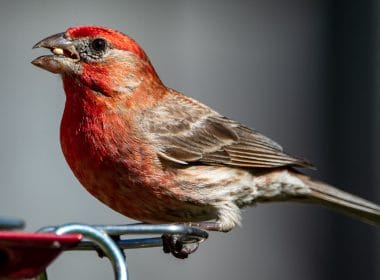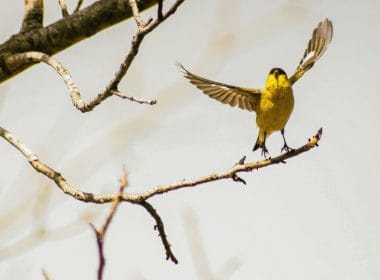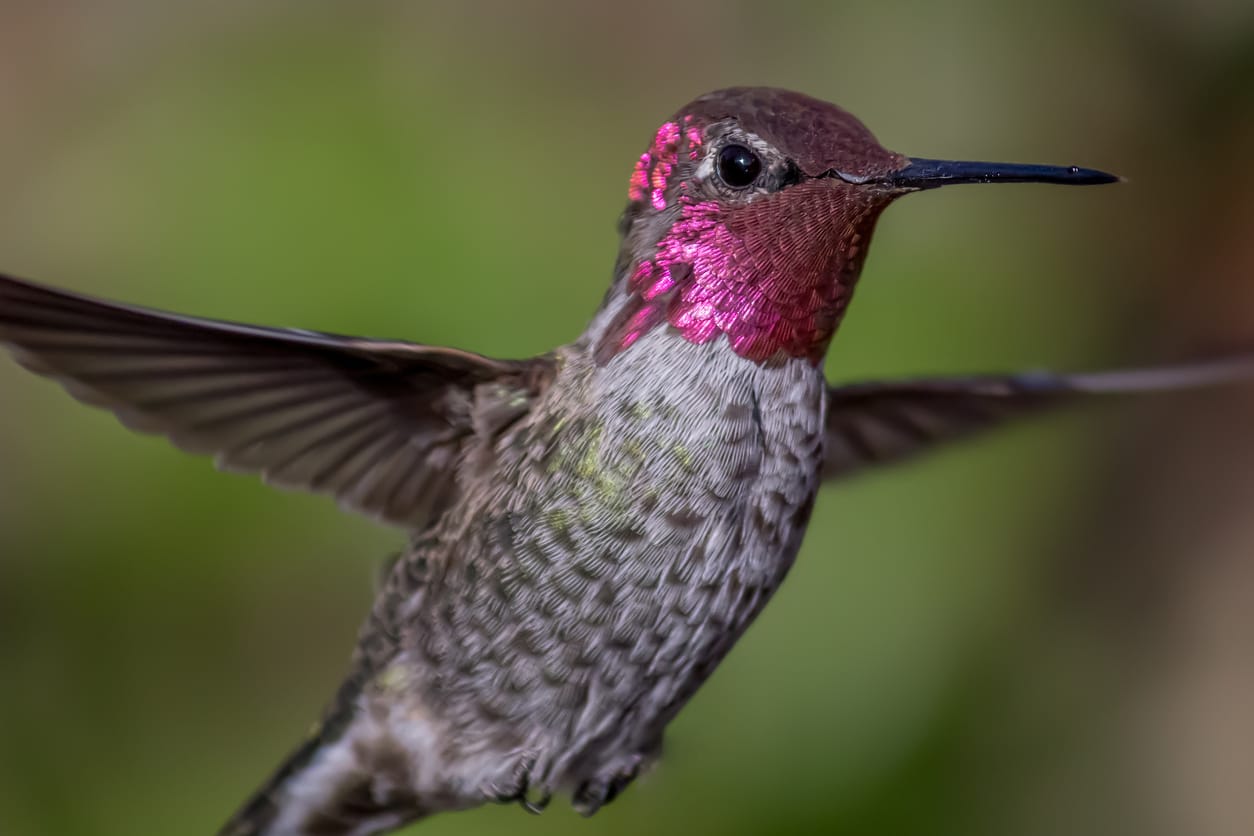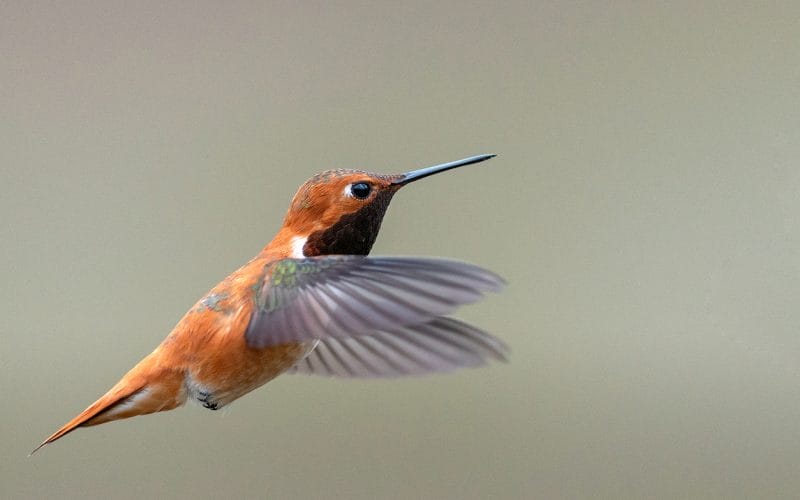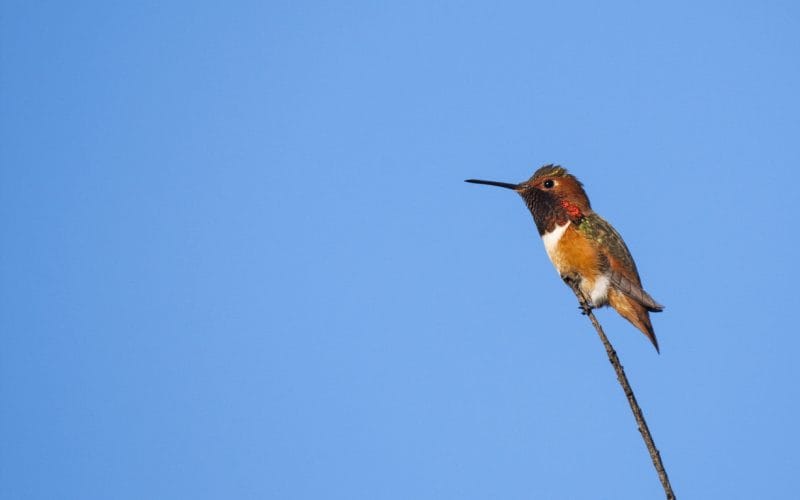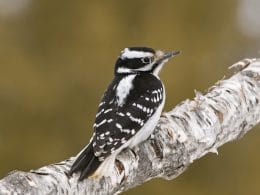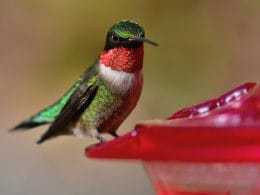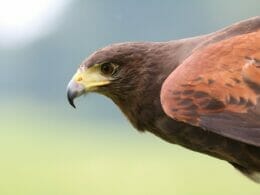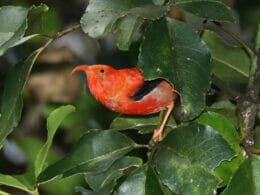Did you know that Hummingbirds are the smallest migrating birds out there? Some hummingbirds could weigh less than a penny and yet they travel thousands of miles either to breed or escape the cold.
Our target today is the state of Tennessee. There are 8 hummingbirds that can be spotted there. Some of them are natives, some are migrants, and some are accidental visitors.
We’ll have a look at all of them in detail.
1. Ruby-throated Hummingbird
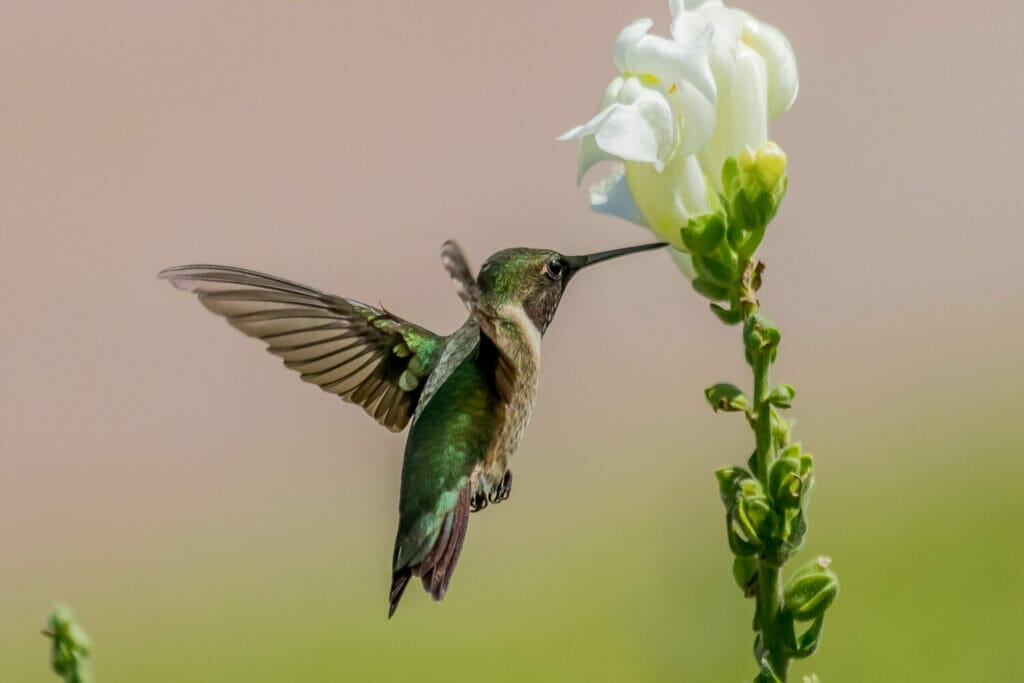
- Scientific name: Archilochus colubris
- Length: 2.9 – 3.5 inches
- Weight: 3.1 g
- Wingspan: 3 – 4 inches
Ruby-throated Hummingbirds are native to the state of Tennessee. They’re one of the most common hummingbirds in the state that can be found at any time of the year.
Ruby-throated Hummingbirds have iridescent-green colors over their backs and wings. The color gets darker to deep brown the closer you get to the wings. These birds have a white belly, a straight dark bill, and a green crown.
Author Note: The male has a distinctive Ruby-colored throat which gave the bird its nickname. The females have thinner and more slender bodies, and they lack that ruby-colored throat.
These hummingbirds have a bright green hue on their backs and heads. Their bellies are covered in white. However, the males have a reddish throat. The females, on the other hand, have brownish heads and sides.
Ruby-throated Hummingbirds breed in Tennessee between April and November. When it gets cold, some of them migrate to Mexico where it’s slightly warmer.
However, you can still find a fair amount of Ruby-throated Hummingbirds in Tennessee even in winter.
Ruby-throated hummingbirds like to nest in open woodland. Parks, flowery backyards, and gardens are all great places to spot some of these Rubies.
It’s highly unlikely that you’ll spot a pair, though. Ruby-throated Hummingbirds are solitary birds and only come together during mating periods.
2. Rufous Hummingbird
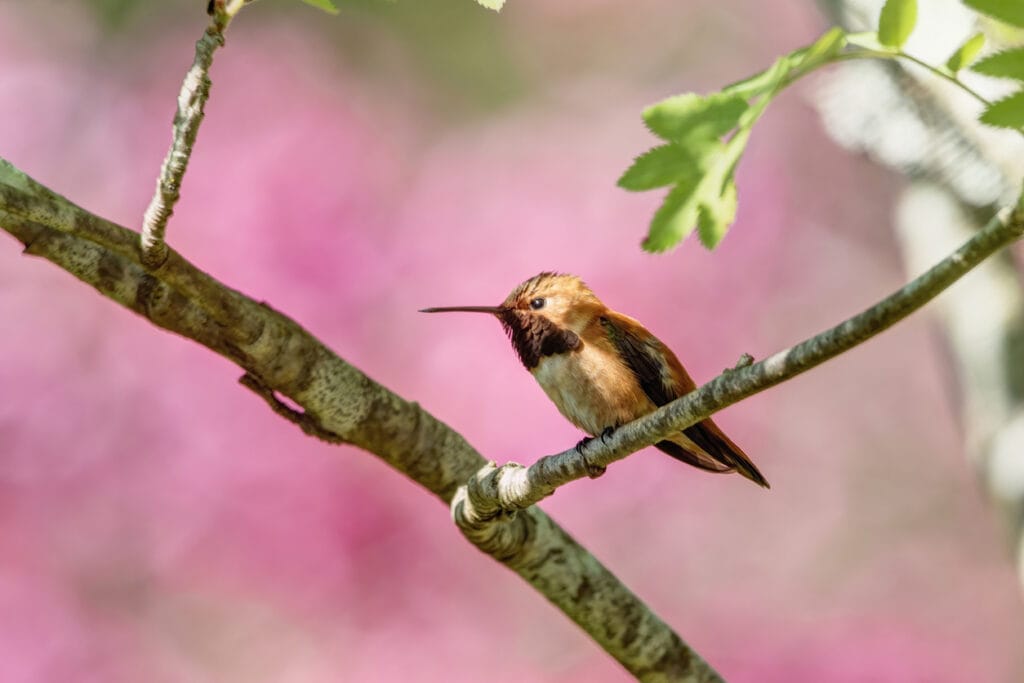
- Scientific name: Selasphorus rufus
- Length: 2.9 – 3.2 inches
- Weight: 3.5 g
- Wingspan: 3.8 – 4.2 inches
Rufous Hummingbirds are one of the near-threatened birds on our list. They are also known to be among the most aggressive hummingbirds out there. They attack other birds of the same species for food and territory even when unprovoked.
Rufous Hummingbirds have an orange coating all over their bodies except for the belly which is white. They have small short dark bills that they use to snatch flying insects and drink nectars.
The males have an iridescent orange/red coating on their throats that females lack. The name “Rufous” came from the male’s rufous gorget.
Rufous Hummingbirds can withstand temperatures as low as -4 degrees Fahrenheit. This allows them to travel further north than any other hummingbird in the United States.]
Rufous hummingbirds have great flying abilities and could travel over 4,000 miles until they reach Alaska.
If you live in Tennessee, you have a good chance of seeing Rufous Hummingbirds from August to April. It’s very rare to spot these birds in the state any other time of the year.
Rufous Hummingbirds feed on nectars and small insects and will fight other birds for food. They’re so aggressive that they sometimes attack squirrels and chipmunks if they get too close to the nest.
3. Allen’s Hummingbird
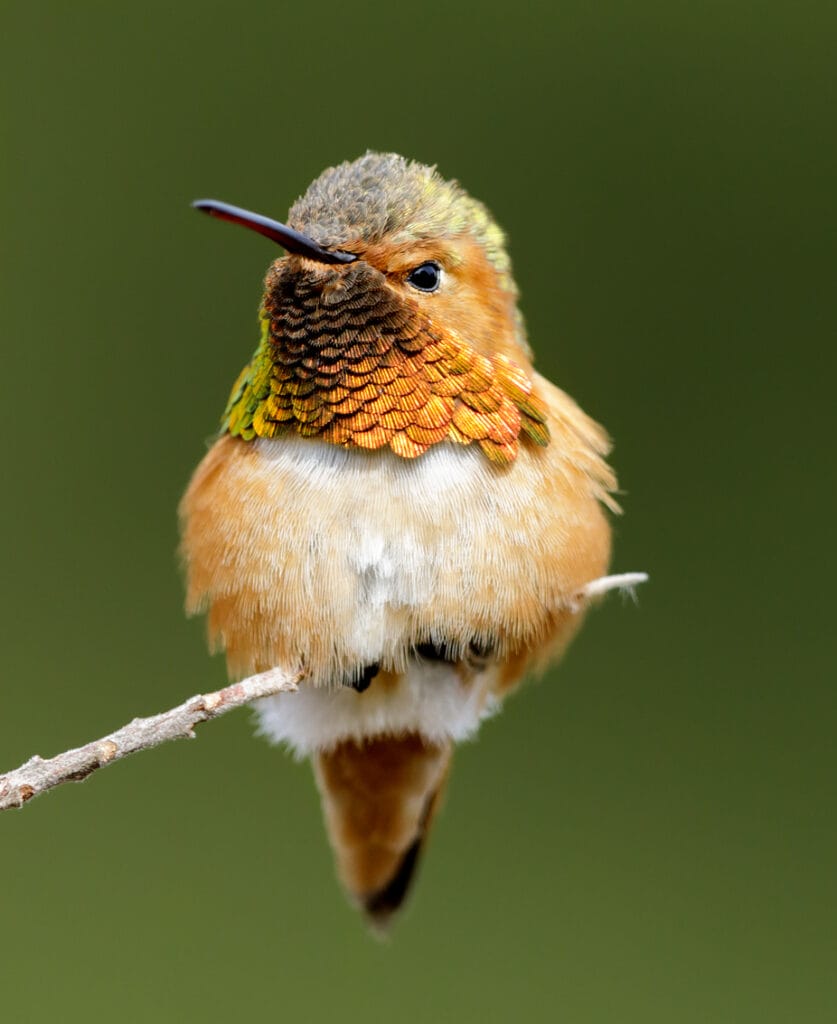
- Scientific name: Selasphorus sasin
- Length: 3 – 3.5 inches
- Weight: 3 g
- Wingspan: 4.3 – 4.7 inches
Allen’s Hummingbirds share a similar look to Rufous Hummingbirds. The Allens’ temper isn’t as bad as the Rufous birds, but they are still somewhat aggressive.
If a male Allen’s Hummingbird spots another male of the same species fly into his territory, he will attack on sight. Even if the trespasser isn’t looking for food, his mere existence triggers the territorial hummingbird to attack.
Male Allen’s Hummingbirds have relatively long bills. Their wings, throats, tails, and eye patches are all light orange. The females have a similar appearance, but their orange is more brownish. They also don’t have the orange color around their throats.
Top Tip: Allen’s Hummingbirds live and breed in Mexico. In migration seasons, they travel to California around January and may rest in Tennessee along the way. That’s when you have the chance to spot them.
Allen’s Hummingbirds don’t consider Tennessee as a breeding or a migratory destination. That’s why they’re considered rare or vagrant in the state.
Allen’s Hummingbirds feed on nectars as their main source of food. They may supplement with some small insects and flies should they spot them around flowers.
4. Calliope Hummingbird
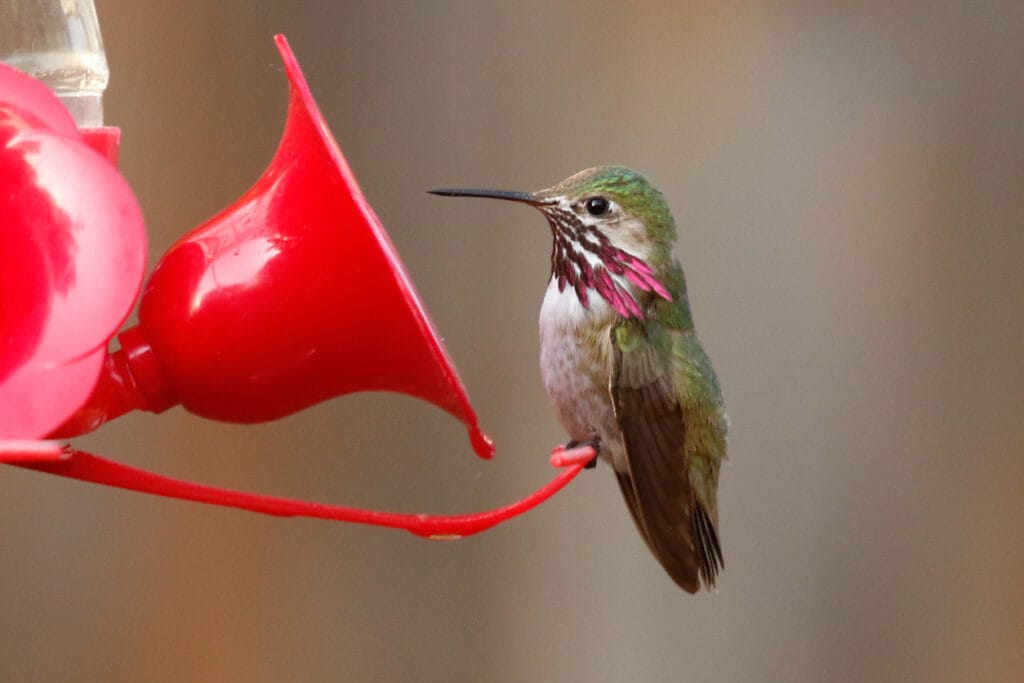
- Scientific name: Selasphorus calliope
- Length: 2.9 – 3.1 inches
- Weight: 2 – 3 g
- Wingspan: 3.8 – 4.3 inches
It’s not easy to spot Calliope Hummingbirds if you live in Tennessee. These hummingbirds don’t breed or migrate to the state, but they may pass through as they travel between states.
Calliope Hummingbirds are the smallest hummingbirds in the United States. The adult male of this species weighs less than a penny.
It’s easy to identify a male Calliope Hummingbird from its purple crown and the long feathers around its throat. Its back is green and the belly is white.
Female Calliope Hummingbirds lack the purple feathers around the neck. Instead, they have a white neck with dark brown spots.
Calliope Hummingbirds prefer to breed in the northern states. California seems to be their preferred breeding state. When the temperature drops, they migrate to the Gulf of Mexico where the temperature is warm.
Calliope Hummingbirds have a limited wintering range. That makes them vulnerable to natural disasters, forest fires, and habitat loss.
They feed on nectars, small spiders, and flying insects. They’re quite territorial despite their small size and weight. It’s not uncommon for a group of Calliope Hummingbirds to gank on Red-tailed Hawks if they get too close.
The oldest living recorded Calliope Hummingbird was a female that managed to reach the age of 8 years and 11 months.
5. Black-Chinned Hummingbird
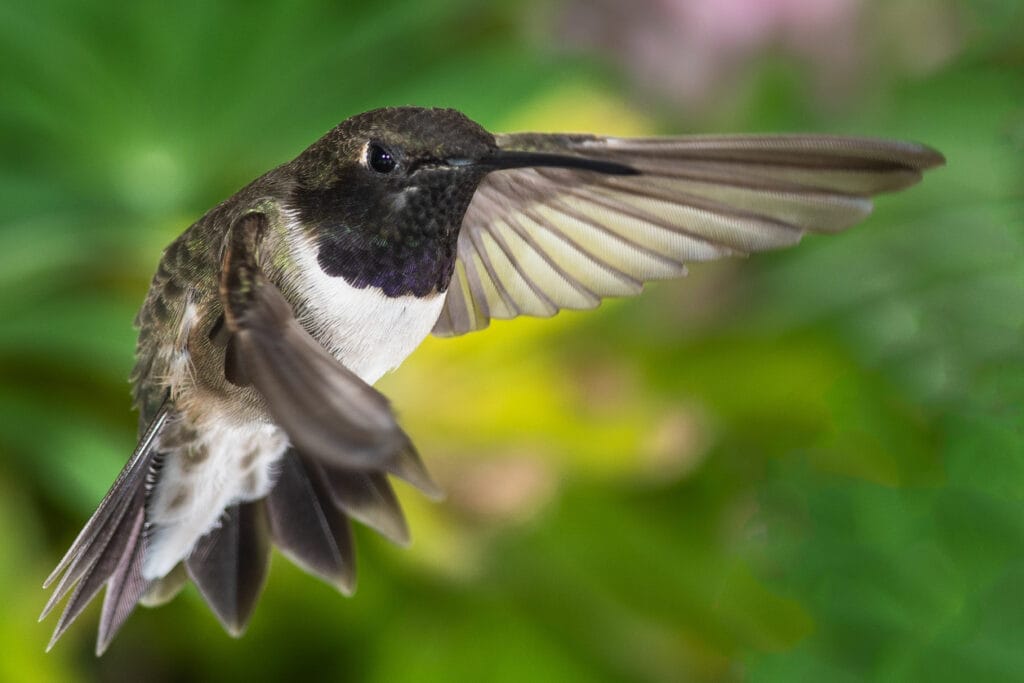
- Scientific name: Archilochus alexandri
- Length: 2.9 – 3.2 inches
- Weight: 3.1 g
- Wingspan: 1.6 – 1.9 inches
Black-Chinned Hummingbirds were discovered in Mexico by a French zoologist named Dr. Alexandre who put his name into the bird’s scientific name.
These Hummingbirds neither breed nor migrate to Tennessee. They pass by the state occasionally which is why they’re rare to find.
Black-Chinned Hummingbirds have a dark gray color on their backs and wings. Their belly is white and their crown is black. The male has a purple lustrous ring under his neck, a feature that the female Black-Chinned birds don’t have.
The body and the slightly curved bill are both of medium to small size. Their tiny bodies often make them prey for other insect-eating birds. To avoid being hunted by other birds, they often nest close to other nests of same-sized birds.
This allows them to use the bird gatherings as distractions should a predator attack.
Whenever there are flowers, there’s a chance you might see a Black-Chinned Hummingbird. It’s rare when you’re in Tennessee, but you could increase your chances of finding one in your backyards by spreading around some nectar feeders.
Author Note: Black-Chinned Hummingbirds would eat the nectar of just any flower. So you don’t have to be around a specific type of flower to attract this bird.
6. Broad-tailed Hummingbird

- Scientific name: Cynanthus latirostris
- Length: 3.2 – 3.8 inches
- Weight: 3.3 – 3.5 g
- Wingspan: 5 – 5.25 inches
Broad-tailed Hummingbirds are medium-sized birds that could be seen in Tennessee on occasion. However, they’re quite rare as they don’t breed nor live in the state.
Broad-tailed Hummingbirds take south Mexico as their home. They could be migrants or non-migrants. The migrant ones travel between February and April to northern states like Wyoming, Colorado, and Montana.
These hummingbirds are nothing short of pretty. Their backs are iridescent green that slowly turns to brown as you reach the terminals. The male has a distinctive red coating that gives off a purple luster. The female, on the other hand, lacks the reddish throat.
The stomachs and eye rings are both white, the bills are black and short, and the tails are broad.
Broad-tailed Hummingbirds are promiscuous which means that males and females don’t bond for life. They only get together when it’s time to breed. The females often raise the chicks alone after that.
When Broad-tailed Hummingbirds breed, they often do so in high altitudes up 1o 10,000. These birds can slow their heart rates down and drop their body temperature to neutralize the cold.
In the 1990s, Broad-tailed Hummingbirds had a severe decline in their numbers. Fortunately, however, their population is stable now.
7. Anna’s Hummingbird

- Scientific name: Calypte anna
- Length: 3.8 – 4 inches
- Weight: 4 – 4.5 g
- Wingspan: 4.3 – 4.7 inches
Anna’s Hummingbirds are more common on the western coast, that’s why they are quite rare to see in Tennessee. They got the “Anna” in their name after Anna Massena, the Duchess of Rivoli.
Anna’s Hummingbird is the only hummingbird in North America that has a red crown. These hummingbirds could be green, magenta, or gray.
They are medium-sized birds who commonly boast a green or gray back, a pale belly, and a violet neck that transits into a black face and bill.
Top Tip: You can find Anna’s Hummingbirds around backyards, nectar feeders, scrubs, and savannah. They mainly feed on small insects, spiders, nectars, and tree sap.
Anna’s Hummingbirds share a lot of their feeding environment with bees and wasps. On some rare occasions, these insects may accidentally impale themselves in the hummingbird’s bill. This could be lethal for the bird.
Fun fact: Anna’s Hummingbirds sometimes eat sand and ashes to provide themselves with minerals. How many times have you seen a bird eat sand?
8. Green-violet-eared Hummingbird

- Scientific name:Colibri
- Length: 2.9 – 3.5 cm
- Weight: 5.6 -5.9 g
- Wingspan: 4.5 – 4.7 inches
Also known as the Mexican Violet-eared Hummingbirds, the Green-violet-eared Hummingbirds got that name from the word “Thalassinus.” A Latin word that means “the color of the sea.”
Green-violet-eared Hummingbirds are not natives to the state of Tennessee which explains their rare appearances there. They’re frequent visitors to a few other states like Wisconsin and Michigan.
Green-violet-eared Hummingbirds are simply beautiful. They have a green covering like most hummingbirds. However, the crown is a mix between blue and green.
Author Note: The neck and the ear area are covered with blue / violet purple. Hence the name “Violet eared.” The wing terminals have brown feathers that sometimes give a purple hue under the right lighting conditions.
Since Green-violet-eared Hummingbirds prefer humidity, they often nest in cloud forests of Mexico and Nicaragua. The forest provides enough flower nectars and small flies for these hummingbirds.
Green-violet-eared Hummingbirds prefer to nest alone and they don’t get together outside mating seasons.
Final Words
Those were the 8 hummingbirds you can find in Tennessee. Keep in mind that many species of hummingbirds are near endangered. So, it would be a good idea to keep some fair distance if you happen to spot one.
Don’t also try to catch them or trap them in cages. These birds are very fragile and entrapment could deteriorate their health quickly. There’s a reason why it’s illegal to have a hummingbird as a pet.
Knowing the right season of when your favorite hummingbird reaches Tennessee is your best chance of spotting the bird you seek.
FAQ
Your own backyard is the best place! Put up hummingbird feeders, sit back and relax.
The Ruby-throated Hummingbird is the most common species in Tennessee.
To find out where recent sightings of hummingbirds have been, try eBird. You can search for the latest sightings or particular species or what has been seen in a certain area.
